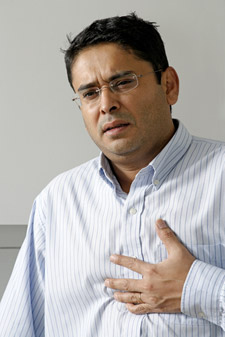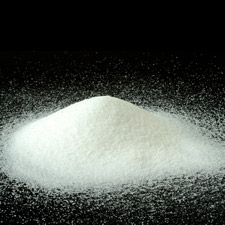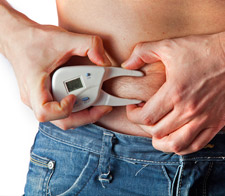
March 21, 2011
Furci Home / Fitness Channel / Bullz-Eye Home
Myth 1: Saturated fat causes heart disease
By the mid 1950s, cardiovascular disease (CVD) became our number one killer, and it remains the leading killer today. It was around this time that the "lipid hypothesis" started to gain popularity. The lipid hypothesis, which was proposed by Ancel Keys in the late 1950s, claims there is a direct relationship between the amount of saturated fat and cholesterol in the diet and the incidence of CVD.
This year in the U.S. more than one million people will have a heart attack, and just short of half will die [1]. About 81.1 million people, or more than 26 percent of the U.S. population, have one or more types of cardiovascular disease [2]. In 2006, as the underlying cause of death, CVD mortality was nearly 34.3 percent of "total mortality" in the U.S. [3] This means that CVD claimed 831,272 lives, or 1 out every 2.9 deaths. It's safe to say CVD has been the number one killer for almost six decades, and to this day shows no signs of giving up that position.
 If saturated fat caused heart disease, with the incidence of CVD still on the rise, one would surmise Americans have had a corresponding increase of their consumption of saturated fats and cholesterol. So what do Americans eat? How does our diet differ from the early 1900s?
If saturated fat caused heart disease, with the incidence of CVD still on the rise, one would surmise Americans have had a corresponding increase of their consumption of saturated fats and cholesterol. So what do Americans eat? How does our diet differ from the early 1900s?
What's decreased?
- Animal fat consumption has dropped over 21 percent since 1910 [4].
- Whole milk consumption has decreased 50 percent [5].
- The consumption of butter has decreased from 18 lbs per year to 4 lbs [4].
What's increased?
- Over the past 80 years, cholesterol consumption has increased a mere 1 percent [4].
- Vegetable oil consumption, including hydrogenated oils, has increased 437 percent [5].
- Sugar consumption went from 5 lbs per year in 1900 to 163 lbs per year today [6].
If animal fats (saturated fats) are so dangerous, and vegetable oils (polyunsaturated fat) are so healthy, why are we so unhealthy as a nation? The scientific data of the past or present does not support the assertion that saturated fats cause heart disease. As a matter of fact, more than 20 studies have shown that people who have had a heart attack haven't eaten any more saturated fat than other people, and the degree of atherosclerosis at autopsy is unrelated to diet [7].
Many studies touting the evidence for the lipid hypothesis have recently been shown to be severely flawed. The few studies that do indicate a correlation between fat reduction and a decrease in coronary heart disease mortality also document a concurrent increase in deaths from cancer, brain hemorrhage, suicide and violent death [8].
The concept that LDL is "bad cholesterol" is a simplistic and scientifically untenable hypothesis. Independent-thinking practitioners must look at the readily available evidence for themselves, instead of relying on the continual stream of anti-cholesterol propaganda emanating from "health authorities." By doing so, they will quickly realize that the LDL hypothesis is aggressively promoted for reasons other than public health" [9].
Roles for saturated fats in the body include:
- They constitute at least 50 percent of our cell membranes and give our cells integrity.
- They play a vital role in the health of our bones.
- They lower Lp(a), a substance in the blood that is said to indicate proneness to heart disease.
- They protect the liver from alcohol and other toxins like Tylenol (acetaminophen).
- They enhance the immune system.
- They are needed for proper utilization of essential fatty acids.
- Stearic acid and palmitic acid, both saturated fats, are the preferred energy source of the heart. This is why the fat around the heart muscle is mainly saturated. The best sources for palmitic acid are beef, butter and palm oil.
- Short and medium chain saturated fatty acids have strong antimicrobial properties. They help protect us from harmful microorganisms. The best sources are tropical oils such as coconut oil and palm oil.
SOURCES
1. Evolution of the Unhealthy American, Bullz-Eye.com.
2. Cardiovascular Disease Statistics, AmericanHeart.org.
3. Heart Stroke Update, AmericanHeart.org.
4. Enig, Mary., and Sally Fallon. "The Skinny on Fats," westonaprice.org.
5. Enig, Mary., and Sally Fallon. "Myths and Truths about Beef." westonaprice.org.
6. "Glyconutrients Explained," 1-a-glyconutrients.com.
7. Ravnskov, Uffe. "The cholesterol Myths: Myth number 4."
8. Severson, Kim. "Trans fat in food: as bad as it gets. Scientists' warning likely to bring listing on nutrition labels." San Francisco Chronicle. 11 Jan, 2002. SFGate.com.
9. Colpo, Anthony. "LDL Cholesterol: Bad Cholesterol, or Bad Science." J of Amer Physicians and Surgeons. 2005; 10(3): 83-89.
Myth 2: Soy is a health food
The following is a list of myths and truths about soy, taken from westonaprice.org.
Myth: Asians consume large amounts of soy foods.
Fact: Average consumption of soy foods in Japan and China is about 10 grams (about 2 teaspoons) per day. Asians consume soy foods in small amounts as a condiment, and not as a replacement for animal foods.
Myth: Soy foods provide complete protein.
Fact: Like all legumes, soy beans are deficient in the sulfur-containing amino acids methionine and cystine. In addition, modern processing denatures fragile lysine.
Myth: Fermented soy foods can provide vitamin B12 in vegetarian diets.
Fact: The compound that resembles vitamin B12 in soy cannot be used by the human body; in fact, soy foods cause the body to require more B12.

Myth: Soy formula is safe for infants.
Fact: Soy foods contain trypsin inhibitors that inhibit protein digestion and affect pancreatic function. In test animals, diets high in trypsin inhibitors led to stunted growth and pancreatic disorders. Soy foods increase the body's requirement for vitamin D, needed for strong bones and normal growth. Phytic acid in soy foods results in reduced bioavailabilty of iron and zinc, which are required for the health and development of the brain and nervous system. Soy also lacks cholesterol, likewise essential for the development of the brain and nervous system. Megadoses of phytoestrogens in soy formula have been implicated in the current trend toward increasingly premature sexual development in girls and delayed or retarded sexual development in boys.
Myth: Soy estrogens (isoflavones) are good for you.
Fact: Soy isoflavones are phyto-endocrine disrupters. At dietary levels, they can prevent ovulation and stimulate the growth of cancer cells. Eating as little as 30 grams (about four tablespoons) of soy per day can result in hypothyroidism with symptoms of lethargy, constipation, weight gain and fatigue.
Myth: Soy isoflavones and soy protein isolate have GRAS (Generally Recognized as Safe) status.
Fact: Archer Daniels Midland (ADM) recently withdrew its application to the Food and Drug Administration for GRAS status for soy isoflavones, following an outpouring of protest from the scientific community. The FDA never approved GRAS status for soy protein isolate because of concern regarding the presence of toxins and carcinogens in processed soy.
Myth: Soy foods are good for your sex life.
Fact: Isoflavones in soy have been shown in several studies to lower total testosterone and increase sex hormone binding globulin which adheres itself to free testosterone rendering it inactive. Numerous animal studies show that soy foods cause infertility in animals. Japanese housewives feed tofu to their husbands frequently when they want to reduce their virility.
Myth 3: Fructose is harmless; it's just like regular sugar.
The "fat carb" has been in our food supply for more than 35 years. We've been led to believe that fructose from high fructose corn syrup (HFCS) is akin to naturally occurring sugar, the same that's found in fruit. Nothing could be further from the truth. The fructose from HFCS is not the same as the molecule from sucrose (table sugar), or fruit leveulose [1]. Is it any wonder they have worked so hard to link HFCS to something natural and healthy like fruit?
 The problem is our bodies metabolize HFCS differently than sucrose or fruit leveulose. When we consume sucrose, our bodies convert it into glucose, which raises our blood glucose levels. We then get an insulin spike to shuttle the glucose where it's needed. When we consume HFCS, unlike natural sugar, it is metabolized in the liver and produces high triglyceride levels which are linked to heart disease. In addition, HFCS does not induce insulin secretion, nor does it boost leptin production, both of which are key signals for decreasing hunger. Hence, the name "fat carb." Eat it, get fat. Eat more, get fatter.
The problem is our bodies metabolize HFCS differently than sucrose or fruit leveulose. When we consume sucrose, our bodies convert it into glucose, which raises our blood glucose levels. We then get an insulin spike to shuttle the glucose where it's needed. When we consume HFCS, unlike natural sugar, it is metabolized in the liver and produces high triglyceride levels which are linked to heart disease. In addition, HFCS does not induce insulin secretion, nor does it boost leptin production, both of which are key signals for decreasing hunger. Hence, the name "fat carb." Eat it, get fat. Eat more, get fatter.
Russ Bianchi, a pharmacologist and toxicologist, explains: "There is no safe form of fructose available from any source, unless already existing in an unprocessed apple or other piece of fruit. The science is known and epidemiologically proven" [2].
If you follow the obesity epidemic in the U.S., you'll find that Americans are eating less fat. In 1965, men ate an average of 139 grams and women 83 grams of fat per day. In 1995, men ate 101 grams and women ate 65 grams of fat per day [3]. With the way fat has been demonized over the last four decades, you'd expect an increase in fat consumption to be the main cause of the obesity epidemic, yet it's not.
What does mirror the increase in fat Americans is the consumption pattern of HFCS. Between the years of 1970 and 1990, HFCS consumption increased 1,000 percent, and today represents 40 percent of the sweeteners added to foods and beverages. In fact, HFCS is the main caloric sweetener in soft drinks in the United States. Is it any wonder that obesity is an epidemic? One of the main ingredients in our food supply not only converts to fat when we consume it, it facilitates fat storage. And Americans as a whole are eating more and more and more.
SOURCES
1. Mercola, J. "Debate about the dangers of high fructose corn syrup." Mercola.com.
2. "Is lots of fructose water foolhardy? Apology, too." Sugarshockblog.com, 13 September 2005.
3. Anand, Rajen S., "Is fat consumption Really Decreasing?" Family Econ and Nut Rev. Summer 1998.
Myth 4: The best type of exercise to cut body fat is cardio
Now don't get me wrong, walking around a mall, around the block, or on a treadmill is better than doing nothing. But I'm not, and you shouldn't be, concerned with what's better than nothing. Are you that lazy and out of shape that walking is exerting yourself? Unless you've been sick, seriously injured, or both, you should be ashamed. I personally am not concerned about being average, let alone being better than nothing. If you're going to put the time in to exercise, use it wisely, do it correctly, and reap the benefits.
If you've ever been to one of the gyms across this country, what percentage of people who perform cardio are lean? More-over, how many people you see performing cardio on a regular basis make gains, and better still, keep them? This harsh reality of the inefficiency of cardio should be enough to get people to try another form of exercise, unless they do it for enjoyment.
There are three things to keep in mind about cardio when trying to get leaner. One is that it doesn't build muscle. Two, it doesn't preserve muscle while losing weight. Both are extremely important if your goal is not only to get leaner, but to stay that way. Lastly, unless you enjoy cardiovascular training, it's just not worth the time. The work-to-benefit ratio is dismal to say the least. Unless you're willing to bust your butt and perform 60 to 90 minutes of cardio a day, which will hinder your muscle-building capacity, cardio is not worth it.
As we lose weight the body does not discriminate where the weight comes from. We lose muscle along with fat, especially on a low calorie diet. Performing cardio accentuates this phenomenon.
If you do nothing but diet and cardio, you may lose some weight, but your results will be less than expected. Your appearance and overall shape will stay the same. If you have excess fat around your butt and narrow shoulders, your proportion will remain. This is not improvement to me, and if it is to you, you're going down the wrong road.
The best and only form of exercise for reshaping your body by losing fat and building muscle is progressive weight training.
Myth 5: Strictly reducing calories is the key to losing body fat
 One of the biggest errors you can make in your plight to reduce body fat is eating only once or twice per day. Our bodies adapt to any stress placed upon it. Programmed through tens of thousands of years for survival, when we restrict the amount of food we eat, our bodies respond by reducing the rate at which we metabolize food. It doesn't matter that you're eating a burger with fries and a soft drink for dinner; by not eating at regular intervals your body kicks into starvation mode and readily stores fat.
One of the biggest errors you can make in your plight to reduce body fat is eating only once or twice per day. Our bodies adapt to any stress placed upon it. Programmed through tens of thousands of years for survival, when we restrict the amount of food we eat, our bodies respond by reducing the rate at which we metabolize food. It doesn't matter that you're eating a burger with fries and a soft drink for dinner; by not eating at regular intervals your body kicks into starvation mode and readily stores fat.
It becomes a vicious cycle. You want to lose weight so you cut back on the amount of food, which for most means eating less times per day. Your body responds by slowing its metabolism, an automatic survival mechanism, no matter what body fat percentage you are.
You lose weight at first, which is both fat and muscle, but eventually hit a plateau. Muscle drives the metabolism. It's what burns fat as fuel. The less you have the less fat you burn.
And if losing muscle and feeling crappy wasn't enough, you are continuously hungry and eventually fall off the wagon. Now you're eating more, with less muscle and a slower metabolism. Your body is now a much less efficient fat burning machine. Now you can eat less than when you started and still gain weight.
The weight you gain when you start eating again (and you will start eating again) will be even greater than when you started your crash diet. Sounds ridiculous doesn't it, but many people do it over and over.
What needs to be done is to eat whole nutritious meals at least four times per day. You need to establish new eating habits and this may take a few months to feel comfortable. Eating in this way will ensure a faster metabolism, higher energy levels, less hunger, and a better outlook. For more information on the best way to lose body fat read Get Shredded!
You can follow us on Twitter and Facebook for content updates. Also, sign up for our email list for weekly updates and check us out on Google+ as well.













